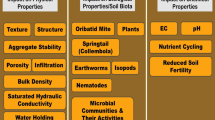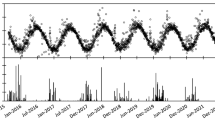Summary
Comparison of clay and plastic pots for tomato propagation in six experiments showed plastic pots to give significantly better results than clay pots in winter and the converse to be true in summer. In each experiment the ratio of plant growth (dry weight) in clay and plastic pots was related to both the mean daily solar radiation and the mean outside night minimum temperature. In winter, plants in both types of container made significantly more growth when stood on open benches than when stood on benches with solid surfaces.
These differences in growth were related to soil temperature, clay pots being cooler than plastic pots, the temperature difference between the types of pot ranging from approximately 1°C by night in winter to 4°C under high intensity solar radiation in summer. In winter, soil temperatures were often below the optimum, and in summer in excess of the optimum.
By day, temperature within the pots showed highly significant correlation with solar radiation, and by night in winter pot temperature was negatively correlated with the difference between the glasshouse and the outside air temperature.
Well-defined horizontal thermal gradients were found, and these were positively correlated with soil temperature. In wet soils the thermal gradients were less than in dry soils, and because of their higher thermal conductivity wet soils were warmer than dry soils.
When the normal evaporative cooling from the porous walls of clay pots was prevented by a bituminous coating, the soil temperature during the night was not significantly different from that in plastic pots. By day, however, soil temperature in non-evaporating clay pots was less than that in evaporating clay pots, due to the lower thermal conductivity of the dry clay wall.
Similar content being viewed by others
References
Bowman, G. E., A comparison of greenhouses covered with plastic film and with glass. XVIth Intern. Hort. Congr. 716–725 (1962).
Boxall, M. I., Some effects of soil temperature on plant growth. E. R. A. report, Ref. W/T 43, (1962).
Bunt, A. C. and Kulwiec, Z. J., The effect of container porosity on root environment and plant growth. II Water. (IN preparation).
Clayton, E. E., The relation of temperature to thefusarium wilt of the tomato. Am. J. Botany10, 71–88 (1923).
Riethmann, O., Der einfluss der bodentemperatur auf das wachstum und die reifezeit der tomaten. Ber. schweiz. botan. Ges.42, 152–168 (1933).
White, P. R., Seasonal fluctuations in growth rates of excised tomato root tips. Plant Physiol.12, 183–190 (1937).
Whittle, R. M. and Lawrence, W. J. C., The climatology of glasshouses, IV Soil temperature. J. Agr. Eng. Research5, 235–240 (1960).
Wijk, W. R. van, and Vries, D. A. der, Periodic temperature variations in a homogeneous soil, in Physics of plant environment, p. 105, North-Holland Publishing Company (1963).
Winspear, K. W. and Morris, L. G., Temperature integrating bottles for measuring mean air temperature. J. Agr. Eng. Research4, 214–221 (1959).
Author information
Authors and Affiliations
Rights and permissions
About this article
Cite this article
Bunt, A.C., Kulwiec, Z.J. The effect of container porosity on root environment and plant growth. Plant Soil 32, 65–80 (1970). https://doi.org/10.1007/BF01372847
Received:
Issue Date:
DOI: https://doi.org/10.1007/BF01372847




